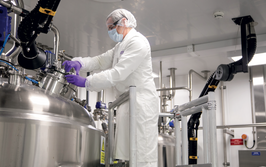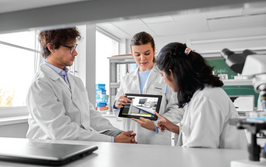Active Manufacturing Responsibility and the Other AMR
Experts from the Access to Medicine Foundation discuss how to reduce the risk of antimicrobial resistance (AMR) in antibiotic manufacturing.
Marijn Verhoef, Martijn van Gerven | | 5 min read | Practical

Antibiotics are a cornerstone of modern medicine, but the rampant rise of drug resistance is threatening their effectiveness – costing lives and endangering millions more.
When the Access to Medicine Foundation first started working on antimicrobial resistance (AMR) in 2016, it was estimated 10 million people would succumb to drug-resistant infections each year by 2050. Alarmingly, we are now seeing that lives lost due to AMR may surpass this sooner than we thought. In 2019 alone, 1.27 million people died of drug-resistant infections, disproportionately affecting people living in low- and middle-income countries.(1)
To minimize the spread of AMR, and to save lives, the development of effective new antibiotics is urgently needed, as is wider access to the full range of antibiotics. This is especially critical in LMICs, where antibiotic access issues are most chronic, and AMR is already hitting hard. But there is another consideration that cannot be ignored; when these lifesaving medicines are produced, antibiotic waste is typically released into rivers and waterways used for drinking water or agriculture. If this waste contains high levels of APIs, it poses a huge risk to the emergence and spread of drug-resistant bacteria, not to mention the harmful impact on the natural environment.
So, what can companies do in the face of needing to expand access to antibiotics, while ensuring their very production doesn’t cause unintended harm? The answer is that, ultimately, by managing antibiotic manufacturing waste responsibly, pharmaceutical companies and their suppliers – in India, China and elsewhere – can proactively cancel out unnecessary, preventable AMR risk.
Seizing opportunities
There are several drivers of AMR, and we at the Foundation have long recognized that targeted actions from pharmaceutical companies are vital to expanding access and curbing drug resistance. For nearly a decade, we have been actively engaging large research-based pharmaceutical companies and generic medicine manufacturers on various critical areas, assessing their current activities and highlighting opportunities for further action. And we have seen progress.
But if we are to stand a chance against the sheer scale and complexity of AMR, companies need to seize every opportunity to tackle it – and when it comes to manufacturing, there are certainly opportunities to do more. A recent report (2) from our AMR Program zeroes in on this issue and examines what antibiotic manufacturers, both large and small, are doing to limit AMR risk in their production processes.
As a vital, logical starting point, companies need to make sure that the wastewater at their own manufacturing sites is sufficiently treated before they release it. Here, antibiotic discharge limits are the key focus – in other words, making sure excessive levels of APIs that trigger do not enter the environment. Our research has shown that most companies comply with discharge limits in receiving waters – which means they are essentially only assessing once their wastewater is already in a river; for example, where antibiotic concentrations may be subject to dilution. Ideally, companies need to comply with discharge limits directly in their wastewater at a manufacturing site to reduce the risk of AMR more effectively. While we have seen examples from companies that do this, we would like to see more companies comply with limits before their wastewater is released into the environment.
Over and above producing antibiotics at their own manufacturing sites, pharmaceutical companies also contract a wide range of third-party suppliers to produce antibiotics – who they can hold to manufacturing standards to ensure AMR risk is reduced throughout the antibiotic supply chain. Here, companies can choose to enforce contractual obligations to ensure supplier compliance – or they can actively engage with suppliers on how to improve practices. This latter approach is incredibly important in ensuring sustainable change without jeopardizing global antibiotic supply. APIs are often produced by a limited number of suppliers – and suppliers often lack the resources to invest in capital-intensive solutions. By supporting them with resources and knowledge, pharmaceutical companies can help suppliers strengthen their efforts.
Transforming actions into impact
As set out in our report, there are methods and techniques companies can employ to bolster efforts at their own manufacturing sites and those of their suppliers – and the standout examples from companies analyzed in the report show encouraging progress. But beyond taking steps to manufacture responsibly, companies also need to be transparent about their efforts so that successes can be shared – and areas for improvement can be clearly identified by independent organizations. How are they determining discharge levels? What waste management techniques are they applying? Are their suppliers compliant? Without this kind of information, it is very difficult to determine what impact is being made. Unfortunately, companies are still falling overwhelmingly short on publicly disclosing details about their manufacturing practices.
Beyond taking responsibility through voluntary action, demonstrating a commitment to manufacture responsibly is becoming a business priority. There is increasing pressure from procurement bodies on AMR, with manufacturing becoming a keener focus – and regulatory developments are looming.
As identified in our report, procurers are already awarding antibiotic tenders to companies that clearly demonstrate responsible manufacturing practices, and investors are also starting to pay attention to this issue as part of their environmental, governance and social considerations in their investment processes. Companies that do not step up now, will lose out in the future.
The path forward
Antibiotic manufacturers, by-and-large, have embraced the fact that they play a vital role in solving AMR. Our research has shown what companies can – and need to – do. While some are more advanced in implementing steps to manufacture responsibly, it shows progress is possible.
More and more people, especially those in LMICs, will need access to essential first- or second-line antibiotics – not only to treat infections with the right antibiotic at the right time, but to avoid an increase in resistance rates that will affect people around the globe. Scaling up access can be done responsibly.
Now it is a matter of ensuring that the right decisions are made, and the right actions are taken to ensure meaningful, sustainable change takes effect across the entire antibiotic supply chain.
- “Global burden of bacterial antimicrobial resistance in 2019: a systematic analysis,” The Lancet (2022). DOI: 10.1016/S0140-6736(21)02724-0
- “Methods matter: What steps are companies taking to help curb AMR by manufacturing responsibly?”, Access to Medicines Foundation (2023). Available at: https://bit.ly/3RiixIC
Director of Operations and Research at the Access to Medicine Foundation, the Netherlands
Research Coordinator for the AMR Programme at the Access to Medicine Foundation, the Netherlands


















